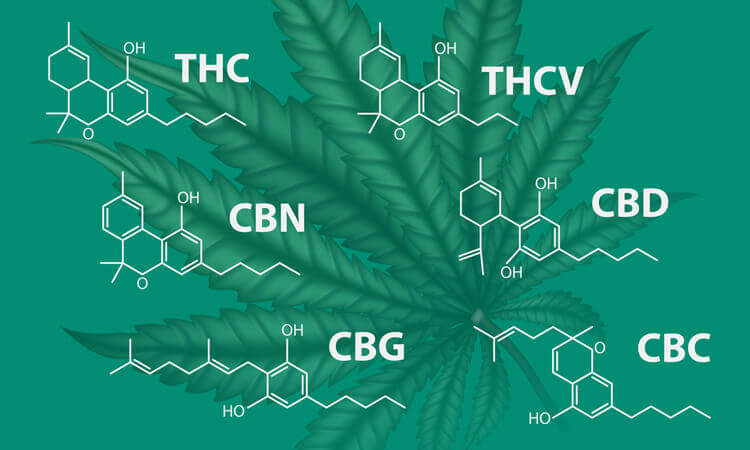Action of the endocannabinoid system
The endocannabinoid system is a system of cannabinoid receptors (CB1 and CB2) found in the human (and animal) body. In simple terms, it can be said to collect and transmit data from the entire body. This data is used to assess and regulate the physiological and psychological processes that make up the overall sense of wellbeing, which we call homeostasis. Maintaining the body's homeostasis is the primary function of this system.
For the system to work efficiently, the body produces endogenous cannabinoids e.g. anandamide and 2-AG.
Impaired function of the endocannabinoid system deregulates the system and prevents proper homeostatic regulation. A disturbed homeostatic process leads to dysfunction and disease. It also prevents self-regulation and impedes the body's self-healing.
A poorly functioning endocannabinoid system means, for example, sleep problems, emotional imbalance, impaired self-regulation of stress. These are just a few examples more information can be found in our knowledge base.
Types of cannabinoids
A popular division of cannabinoids provides for three types of these chemical compounds:
- Plant cannabinoids - plant cannabinoids are most abundant in hemp plants (all varieties: Sativa, Indica and hybrids); we now know that they can also be found in coneflowers and nightshades. 70 cannabinoids, of which the properties of the main several such as CBD, THC or CBG are already fairly well known; plant cannabinoids are not water-soluble, but only in fats and alcohols; this group also includes acid forms of cannabinoids, e.g. CBDA, or cannabidiol acid; hemp products such as e.g. dries, teas or CBD oil contain cannabinoids from legally cultivated hemp; alternative name: phytocannabinoids;
- Endocannabinoids - endogenous cannabinoids are produced inside the body for self-regulation of homeostasis; their function is to activate CB1 or CB2 receptors to trigger a specific body response or human behaviour, e.g. pain relief in response to a pain signal or the decision to take shelter in the shade in response to increased body temperature in the sun, examples: anandamide (AEA) and 2-Arachidonylglycerol (2-AG);
- Synthetic cannabinoids - Synthetic cannabinoids are not perfect copies of plant cannabinoids, but only artificially modified imitations with similar but usually much stronger effects; the use of artificial cannabinoids of unknown origin is dangerous to health and life;

Cannabinoids - classification
The classification of natural cannabinoids provides the following breakdown:
- Cannabinoid precursors - CBGA and CBGV are where the process of acid synthesis, i.e. the conversion of precursors to acidic forms, and the decarboxylation of cannabinoid precursors to neutral/proper forms begins,
- Acidic forms of cannabinoids (RAW) - the primary forms of cannabinoids that develop in the cannabis plant during the process of growth and biosynthesis; it is from these that the specific forms of cannabinoids are formed when exposed to heat (decarboxylation); they are somewhat limited in scope but much more potent in their effects; acid forms of cannabinoids include: CBDA, CBDVA, THCA, THCVA, CBDVA, CBCA, CBCVA
- Decarboxylated cannabinoids (specific, neutral) - are formed by thermal decarboxylation (under the influence of solar heat, during drying and in laboratory decarboxylation processes); acidic forms are transformed into specific ones with a much wider range of properties but lower potency; metabolites are usually formed by natural degradation processes under specific conditions
- Specific/neutral cannabinoids are divided into subclasses:
- Cannabigerols (CBG)
- Cannabichromes (CBC)
- Cannabidiol (CBD and CBDV)
- Tetrahydrocannabinols (THC and THCV)
- Cannabinol (CBN) and Cannabinodiol (CBDL)
- Others including metabolites: Cannabicyclol (CBL), Cannabitriol (CBT), Cannabielsoin (CBE)
- Specific/neutral cannabinoids are divided into subclasses:
- Aged cannabinoids - over time, under the influence of oxidation, some acidic and specific forms of cannabinoids are transformed into late cannabinoids [see infographic below].
Properties of cannabinoids
The logical conclusion of this article is to summarise in one place all the known properties of cannabinoids. Based on the English-language material available online, which I indicate in the sources, I have developed a Polish-language version of an infographic presenting Cannabinoid transformation pathways from precursors to late cannabinoids along with their properties.
It is worth remembering, for example, that actual therapeutic effects of cannabidiol is derived from its properties. Of course, this principle applies not only to CBD or THC, but to all cannabinoids.
Cannabinoid phytochemicals act by interacting with the receptors of the endocannabinoid system. The effect of cannabinoids depends on the location of the receptors.
For example:
Action on limbic system receptors in the brain can affect memory, cognitive and psychomotor functions. This is important in terms of the ability to learn and driving under the influence of or after using cannabis products with THC. In turn, interaction with the mesolimbic dopaminergic system can modulate dopamine release and therefore the functioning of the reward system while affecting stimulus-response processes and pain (pain perception).
I discuss individual cannabinoids, their properties and effects in detail in separate articles. You can find them on the blog and in the knowledge base.
I encourage you to use the graphic below, asking only that you acknowledge its source.
You can also download it and use it to your heart's content by clicking here: Cannabinoids and their properties [PDF].

Sources:
- www.richardrosereport.com
- wikipedia.pl
- https://www.ncbi.nlm.nih.gov/pmc/articles/PMC4351512/
- https://thethccenter.com/introduction-to-cannabis/
